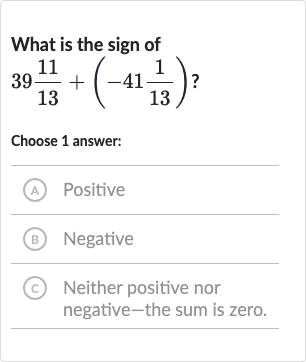Full solution
Q. What is the sign of Choose answer:(A) Positive(B) Negative(C) Neither positive nor negative-the sum is zero.
- Calculate first term: Calculate the first term of the sum.The first term is . To simplify this, we divide by and then multiply by .So, the first term is .
- Calculate second term: Calculate the second term of the sum.The second term is . To simplify this, we divide by ., which can be rounded to for simplicity, but since we are only interested in the sign, we can note that the result is negative.So, the second term is approximately .
- Add terms together: Add the two terms together.Now we add the first term () to the second term ().The sum is positive because is greater than , and subtracting a smaller positive number from a larger positive number results in a positive number.
More problems from Division with rational exponents
QuestionGet tutor help
QuestionGet tutor help
QuestionGet tutor help
QuestionGet tutor help
QuestionGet tutor help
QuestionGet tutor help
QuestionGet tutor help
QuestionGet tutor help

